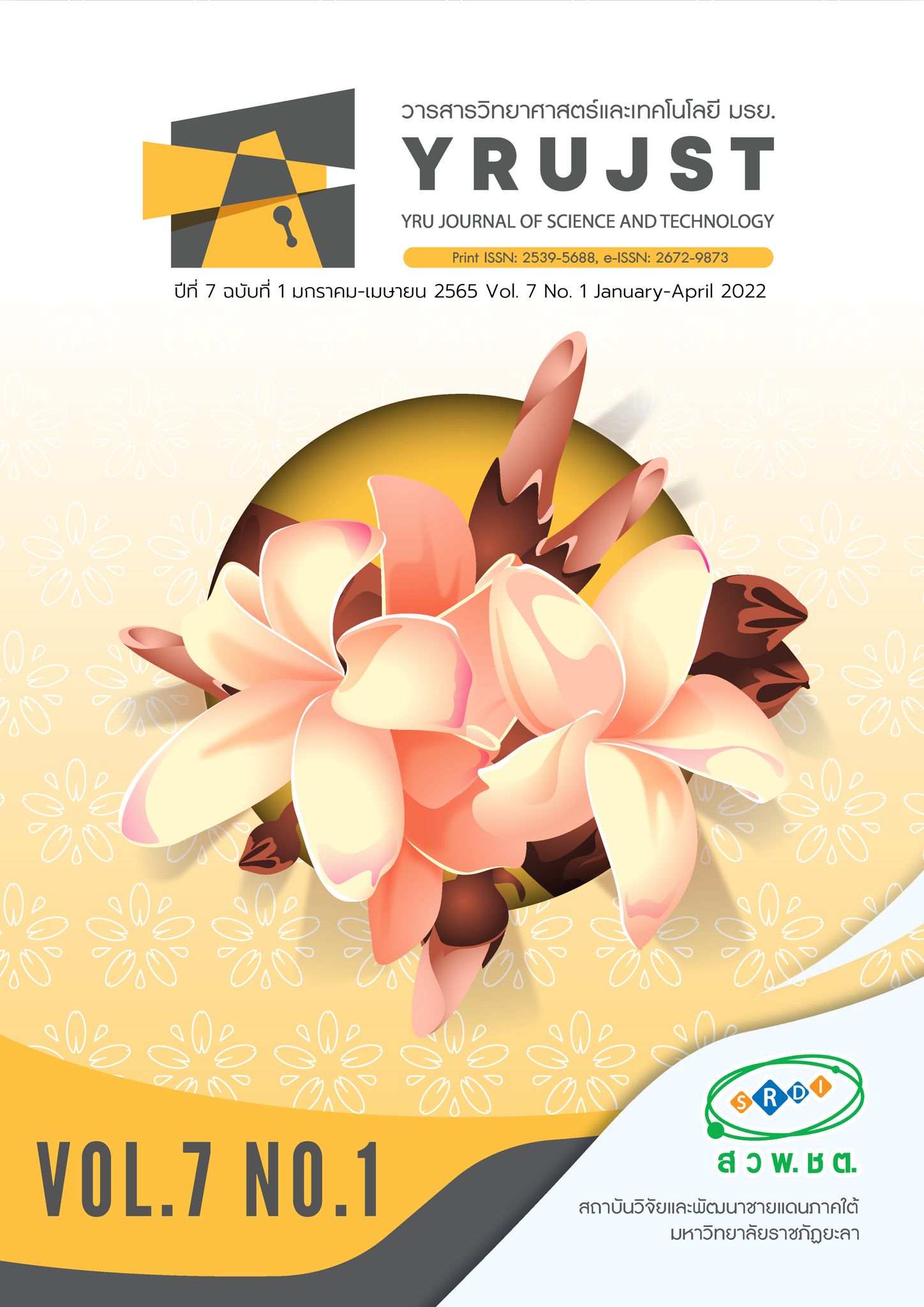อุณหภูมิที่เหมาะสมและสภาวะการเตรียมขั้นต้นร่วมต่อคุณภาพของสาหร่ายพวงองุ่นอบแห้ง
Main Article Content
บทคัดย่อ
สาหร่ายพวงองุ่นเป็นสาหร่ายที่มีคุณค่าทางอาหารสูงจึงได้รับการส่งเสริมเพาะเลี้ยงเชิงพาณิชย์ อย่างไรก็ตาม สาหร่ายพวงองุ่นสดมีอายุหลังการเก็บเกี่ยวสั้น การพัฒนาผลิตภัณฑ์สาหร่ายพวงองุ่นอบแห้งพร้อมรับประทานจึงมีความจำเป็นในการยืดอายุการเก็บรักษาผลิตภัณฑ์ เพื่อเพิ่มช่องทางในการจำหน่ายผลิตภัณฑ์ และเพิ่มโอกาสให้ผู้บริโภคสามารถรับประทานได้สะดวกขึ้น การพัฒนาผลิตภัณฑ์นี้ศึกษาอุณหภูมิอบแห้งที่ 40, 50, 60 และ 70 องศาเซลเซียส และศึกษาวิธีการเตรียมขั้นต้นก่อนการอบแห้งที่มีผลกระทบต่อคุณภาพผลิตภัณฑ์ การเตรียมขั้นต้นแบ่งออกเป็น 2 กลุ่ม คือ ลวก และไม่ลวก แต่ละกลุ่มแช่ตัวอย่างด้วยกรดซิตริกร้อยละ 0.5 หรือแคลเซียมคลอไรด์ร้อยละ 0.5 ผลการศึกษาพบว่า ค่า aw ของทุกตัวอย่างต่ำกว่า 0.45 ตั้งแต่เวลา 150 นาที ตัวอย่างอบแห้งที่ 50 และ 60 องศาเซลเซียส มีค่าการคืนตัวใกล้เคียงกันสภาวะที่เหมาะสมในการอบแห้ง คือ อุณหภูมิ 50 องศาเซลเซียส เวลา 180 นาที จากการเตรียมขั้นต้น พบว่า ตัวอย่างที่แช่ด้วยกรดซิตริกหรือแคลเซียมคลอไรด์มีค่าความชื้นมากกว่าตัวอย่างอื่น (p<0.05) อย่างไรก็ตาม การแช่สาหร่ายพวงองุ่นด้วยกรดซิตริกส่งผลให้สีของผลิตภัณฑ์มีค่าลดลงมากกว่าตัวอย่างอื่น จากการประเมินคุณภาพทางประสาทสัมผัสตัวอย่างทุกตัวอย่างได้รับคะแนนความชอบในระดับปานกลางถึงมากทุกคุณลักษณะ ดังนั้น การพัฒนาผลิตภัณฑ์สาหร่ายพวงองุ่นอบแห้งนี้มีขั้นตอนการผลิตโดยใช้วิธีการลวกหรือไม่ลวกตัวอย่างร่วมกับการแช่แคลเซียมคลอไรด์ และอบแห้ง 50 องศาเซลเซียส เวลา 180 นาที ข้อค้นพบนี้สามารถนำไปใช้เป็นแนวทางในการพัฒนากระบวนการผลิตสาหร่ายพวงองุ่นอบแห้งพร้อมรับประทานเพื่อต่อยอดในเชิงพาณิชย์ได้
Article Details
บทความ ข้อมูล เนื้อหา รูปภาพ ฯลฯ ที่ได้รับการเผยแพร่ในวารสารวิทยาศาสตร์และเทคโนโลยี มรย. นี้ ถือเป็นลิขสิทธิ์ของวารสารวิทยาศาสตร์และเทคโนโลยี มรย. หากบุคคลหรือหน่วยงานใดต้องการนำทั้งหมดหรือส่วนหนึ่งส่วนใดไปเผยแพร่ต่อหรือกระทำการใดๆ จะต้องได้รับอนุญาตเป็นลายลักษณ์อักษรจากวารสารวิทยาศาสตร์และเทคโนโลยี มรย. ก่อนเท่านั้น
เอกสารอ้างอิง
Ahn, H. & Choe, E. (2015). Effects of Blanching and Drying on Pigments and Antioxidants of Daraesoon (Shoot of the Siberian Gooseberry Tree, Actinidia arguta Planchon). Food Sci. Biotechnol., 24(4), 1265-1270.
Anantpinijwatna, A., Nuntamongkol, S., Tudkesorn, B., Sukchoy, O. & Deetae, P. (2018). The Kinetic Model and Temperature Effect of Caulerpa Lentillifera Drying Process [Online]. In AIP Conference Proceedings. Indonesia: AIP Conference Proceedings. Retrieved December 2, 2020, from https://www.researchgate.net/publication/328609464_The_kinetic_model_and_temperature_effect_of_
Caulerpa_Lentillifera_drying_process
Chinnasarn, S. & Krasaechol, N. (2020). Effect of Pretreatment and Drying Conditions on Quality of Dried Green Caviar Product. The Journal of KMUTNB, 30(4), 668-677. (in Thai)
Coastal Aquaculture Research and Development Division. (2017). Cultivation and Post-harvest Management of Caulerpa lentillifera. Thailand: Department of Fisheries, Ministry of Agriculture and Cooperatives [Online]. Retrieved December 2, 2020, from https://www4.fisheries.go.th/local/file_document/20170808161509_file.pdf (in Thai)
Deng, L., Mujumdar, A. S., Zhang, Q., Yang, X., Wang, J., Zheng, Z., Gao, Z. & Xiao, H. (2017). Chemical and physical pretreatments of fruits and vegetables: Effects on drying characteristics and quality attributes – a comprehensive review [Online]. Critical Reviews in Food Science and Nutrition. Retrieved December 2, 2020, from https://doi.org/10.1080/10408398.2017.1409192
Domozych, D. S., Ciancia, M., Fangel, J. U., Mikkelsen, M. D., Ulvskov, P. & Willats, W. G. T. (2012). The cell walls of green algae: a journey through evolution and diversity. Front. Plant Sci., 3(82), 1-7.
Hoan, N. X., Quan, D. H., Dong, D. H., Phuong, N. T., Yen, D. T., Cuong, D. X., et al. (2020). Effect of Drying Methods on Sensory and Physical Characteristics, Nutrient and Phytochemistry Compositions, Vitamin, and Antioxidant Activity of Grapes Seaweed Caulerpa lentillifera Grown in Vietnam. J. Pharm. Sci. & Res., 12(5), 624-630.
Hosseinizand, H., Sokhansanj, S. & Lim, C. J. (2018). Studying the drying mechanism of microalgae Chlorella vulgaris and the optimum drying temperature to preserve quality characteristics. Drying Technology, 36(9), 1049-1060.
Janowicz, M. & Lenart, A. (2018). The impact of high pressure and drying processing on internal structure and quality of fruit. European Food Research and Technology, 244, 1329–1340.
Jönsson, M., Allahgholi, L., Sardari, R. R. R., Hreggviðsson, G. O. & Karlsson, E. N. (2020). Extraction and Modification of Macroalgal Polysaccharides for Current and Next-Generation Applications. Molecules, 25, 930.
Karam, M. C., Petit, J., Zimmer, D., Djantou, E. B. & Scher, J. (2016). Effects of drying and grinding in production of fruit and vegetable powders: A review. Journal of Food Engineering, 188, 32-49.
Liu, H., Chen, F., Lai, S., Tao, J., Yang, H. & Jiao, Z. (2017). Effects of calcium treatment and low temperature storage on cell wall polysaccharide nanostructures and quality of postharvest apricot (Prunus armeniaca). Food Chem., 225, 87–97.
Nyangena, I., Owino, W., Ambuko, J. & Imathiu, S. (2019). Effect of selected pretreatments prior to drying on physical quality attributes of dried mango chips. Journal of Food Science and Technology, 56(8), 3854–3863.
Pramuang, S. (2017). Moisture diffusivity and energy consumption in palm oil fruit drying. KKU Science Journal, 45(4), 896-903. (in Thai)
Pradana, G. B., Prabowo, K. B., Hastuti, R. P., Djaeni, M. & Prasetyaningrum, A. (2019). Seaweed Drying Process Using Tray Dryer with Dehumidified Air System to Increase Efficiency of Energy and Quality Product. IOP Conf. Series: Earth and Environmental Science, 292, 012070.
Rodríguez-Jasso, R. M., Mussatto, S. I., Pastrana, L., Aguilar, C. N. & Teixeira, J. A. (2013). Extraction of sulfated polysaccharides by autohydrolysis of brown seaweed Fucus vesiculosus. Journal of Applied Phycology, 25, 31–39.
Saniso, E., Prado, M. & Yayee, F. (2013). Optimal Condition of Mushroom Drying Using Solar Energy Combined with Infrared Radiation. Journal of Yala Rajabhat University, 8(2), 107-117.
Sharif, M. K., Butt, M. S., Sharif, H. R. & Nasir, M. (2017). Sensory Evaluation and Consumer Acceptability. In M.S. Butt & T. Zahoor. (Eds.), HandBook of Food Science & Technology. Pakistan: UAF Press.
Syamsuddin, R., Azis, H.Y., Badraeni, B. & Rustam. (2019). Comparative study on the growth, carotenoid, fibre and mineral content of the seaweed Caulerpa lentillifera cultivated indoors and in the sea. IOP Conf. Ser. Earth Environ. Sci., 370, 012019.
Yuenyongputtakal, W. & Worasingh, S. (2016). Shelf Life Extension of Ready to Eat Green Caviar (Caulerpa lentillifera) using Edible Film Coating [Online]. Research report, Faculty of Science, Burapha University. Retrieved December 2, 2020, from http://dspace.lib.buu.ac.th/xmlui/handle/1234567890/3506?show=full. (in Thai)


